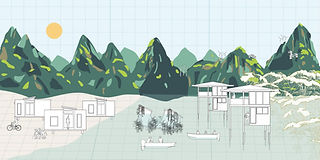STUDENT WORK
Sensorial stimuli are crucial for our ability to perceive space. This allows us to process information about our surroundings so we can
recognize our relationship with them. The signals received from the eyes, nose, ears, and skin allow for the brain to create a mental image of our environment. We are able to calculate light, reverberation and echo, material quality, temperature, and distance via these signals that situate us within our reality. Without them we would not be able to understand our relationship to space in the same way. The body then responds to these stimuli and negotiates itself within the environment. Our experience of space is directly linked to our perception of it. Manipulating sensorial experience allows for reinterpretations of perception and ultimately provides an exploration into other modes of perceiving ourselves within space and our relationship to other bodies. Allowing architecture to become more responsive provides an opportunity to create dialogue between perceiver and perceived, renegotiating the role of design as an active, rather than static or passive, participant in the production of experience.
“No artistic practice is spared the examination of the role of the human body in the work, whether the body is the subject, the tool or the negated presence.”
-Madeline Schwartzman, See Yourself Sensing
Participating Students: Alia Varawalla, Craytonia Williams, David Douglas, Ella Knight, Jiayi Cai, Lily Gucfa, Ruth Wondimu, Thierry Andrianambini, Uthman Olowa, Wenjie Wang, Yingkai Xiong
Be sure to follow us! @sensingspacestudio


This advanced studio was conducted in the Fall 2022 by master and undergraduate students at RISD. Please see some of the work the studio created.
Above: Alia Varawalla, mapping diagram visualizing climate evolution
To the left: Alia Varawalla, a short video imagining what a future climate interface might reveal
Below: Alia Varawalla, visualizations demonstrating climate evolution





Above: Ella Knight






Above: Lily Gucfa

Above: Wenjie Wang
